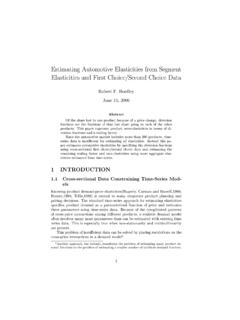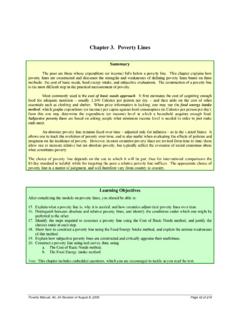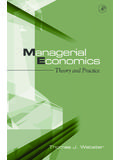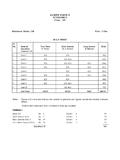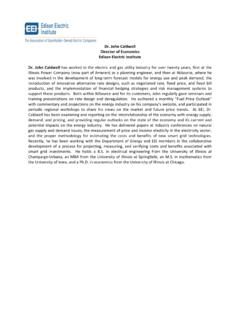Transcription of Estimating price and income elasticity of demand - …
1 Estimating price and income elasticity of demand Introduction The responsiveness of tobacco consumption to price and income increases is measured by the price and income elasticity of demand respectively. Policy makers are interested in learning about the price sensitivity of tobacco consumption with a view to predicting the possible impact of tobacco tax increase that causes tobacco price to increase leading to decrease in tobacco consumption. This presentation elaborates the methods of Estimating price and income elasticity of demand including selection of demand model, data requirement, specification of functional form and the estimation issues.
2 Outline Definition, sign and value of price / income elasticity Examples of price / income elasticity estimates Data types for price / income elasticity estimation Selection of the demand model Model specification for price / income elasticity estimation Endogeneity of price variable Tax elasticity of demand Net effect of simultaneous price and income change price elasticity defined The effect of price change on demand is measured by price elasticity . price elasticity is defined as the percentage change in consumption in response to 1% change in price .
3 Suppose, P1 = initial price per pack of cigarettes Q1 = number of packs of cigarettes sold at price P1 P2 = new price per pack of cigarettes Q2 = number of packs of cigarettes sold at price P2 Then price elasticity of demand for cigarettes is given by Sign and value of price elasticity price elasticity is usually negative indicating that when price goes up, consumption goes down and vice versa. The greater the absolute value of price elasticity , the higher the price sensitivity of demand . For tobacco products, price elasticity is usually less than 1 or tobacco demand is price inelastic.
4 It means when price increases, tobacco consumption decreases by a lesser percentage compared to the price increase. A price elasticity of indicates that when price increases by 10%, demand reduces by 4% in a reasonable period of time that allows the consumers to adjust that tobacco use behavior. In effect, the cut down in aggregate consumption is expected to appear in the monthly or annual sales data available from government sources. Given the price elasticity of demand , it is possible to predict the amount of reduction in consumption in response to a price increase.
5 For example, if price elasticity is and price increases by 20%, one can expect that consumption would go down by x 20% =8%. If initial consumption was 100 units, it can be expected that the 20% price increase would lower consumption to 92 units. Examples of price elasticity estimates The studies examining the impact of tobacco product prices on overall tobacco use are numerous. A majority of these studies came from high- income countries including United States, Canada, United Kingdom, Australia, and several others.
6 But there is growing evidence on the negative effect of tax and price increase on tobacco consumption from low and middle- income countries as well. These studies have estimated a wide range of price elasticities with most, but not all, indicating that demand for tobacco products is more responsive to price in low and middle- income countries than it is in high- income countries. Country Cigarette price elasticity Source Bulgaria Sayginsoy (2002) Taiwan Lee (2007) Republic of Korea Chung et al. (2007) Indonesia Adioetomo et al.
7 (2005) United Kingdom Jones (1989) Egypt Hanafy et al. (2011) USA Franz (2008) Data types for price elasticity estimation Aggregate time-series data ( , per capita sales of cigarettes and annual average price for a country over time) Cross-sectional data Aggregate cross-sectional data for countries, states, provinces, etc. Individual cross-sectional data from household surveys Time-series of cross-sectional data Panel /longitudinal data (repeated observations of the same unit over time) Pooled data of cross-sectional observations Time series data allows one to calculate the percentage change in total tobacco consumption and the percentage change in the average price from one period to the other.
8 The ratio of these two percentages provides the average price elasticity over the time interval. Cross-sectional data allows one to estimate price elasticity by utilizing cross-sectional variation in consumption and price to determine the price sensitivity across the population at a point in time. Selection of the demand model Conventional demand models: static, looks at the effect of explanatory variables on the dependent variable within a single period of time. Addictive demand models: dynamic, looks at the effect of demand in the future and/or demand in the past as well as other explanatory variables in the current period on the demand variable Myopic addiction model: demand in the past is used as an explanatory variable Rational addiction model: both demand in the past and demand in the future period are used as explanatory variables Model specification for price elasticity estimation demand function.
9 Consumption = f (own price , price of substitutes/compliments, income , policy and environmental factors) Linear model: Both dependent and independent variables are used as levels price elasticity = Coefficient of price x Average price /Average consumption Log-linear model: The dependent variable is expressed as logarithm of the original level and the independent variables are used as level price elasticity = Coefficient of price x Average price The dependent variable is used as level and the independent variables are logarithmic transformation of the original levels price elasticity = Coefficient of log price /Average consumption Double log model.
10 Logarithm is taken of both dependent and independent variables price elasticity = Coefficient of log price Detailed description can be found in World Bank Economics of Tobacco Toolkit: Economic Analysis of Tobacco demand Endogeneity of price variable The quantity and price are simultaneously determined in the market by the equilibrium of demand and supply. It means price is endogenous. Failure to account for endogeneity of price may result in bias in the price elasticity estimate. One possible solution is to use instrumental variable technique: Find variables that are correlated with price but do not directly influence demand .










